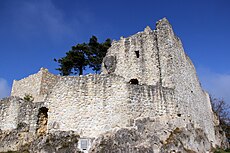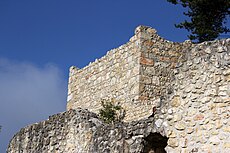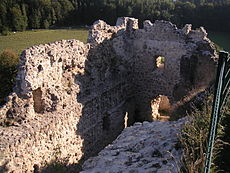Lichtenegg castle ruins (Birgland)
| Lichtenegg castle ruins | ||
|---|---|---|
|
View of Lichtenegg castle and village from the south |
||
| Creation time : | Probably after 1188 | |
| Castle type : | Höhenburg, summit location | |
| Conservation status: | restored ruin | |
| Standing position : | Ministeriale | |
| Construction: | Quarry stone masonry | |
| Place: | Birgland- Lichtenegg | |
| Geographical location | 49 ° 28 '51.9 " N , 11 ° 35' 35" E | |
| Height: | 585 m above sea level NN | |
|
|
||
The Lichtenegg castle ruins are the remnants of a presumably high medieval aristocratic castle above the village of the same name, Lichtenegg, in the municipality of Birgland in the Upper Palatinate district of Amberg-Sulzbach in Bavaria .
The castle was first mentioned more than 700 years ago in the Nuremberg Reichssalbüchlein , but is probably much older. It belonged temporarily to the Reichsvogtei Nuremberg and changed hands frequently until it was destroyed in the 15th century. Since 1998 the facility, which is now owned by the municipality of Birgland, has been restored, also with private funds.
The castle ruins are freely accessible at all times. From here you have a view from the Upper Palatinate Jura , part of the Franconian Jura , to the Fichtel Mountains .
Geographical location
The ruin of the Höhenburg is located directly above the village of Lichtenegg on the summit of the 585 meter high Burgberg, which slopes north into the valley of the Högenbach , and is about 6.4 kilometers east-southeast of the church in Pommelsbrunn .
The castle ruins can be easily reached from the village of Lichtenegg.
Nearby is the castle ruin Lichtenstein on the Schleußberg above Pommelsbrunn, also near Pommelsbrunn is the Burgstall Altes Haus on the Mühlkoppe. To the north is the Breitenthal castle stable above the village of Oed and the Kuhfels castle stable to the east, south of the village of Bachetsfeld.
Also on the Spitzigen Berg, immediately east of Lichtenegg, altitude mark 577.5, was the probably prehistoric section fortification Schweinberg , of which only a remnant of a moat with an outer wall can be seen.
History of the castle
The area around the castle was settled between 5000 and 5500 years ago. This is proven by cord ceramic finds in a prehistoric stone wall.
Despite the early decline of the castle complex, an astonishingly high number of different historical news has been preserved. This is closely related to the very changeable ownership and lordship, especially at the time of the numerous divisions and fratricidal wars of the Wittelsbach family .
Nevertheless, the origins of the castle remain hidden in the dark of history; but has been further clarified by new research results on the Ortschronik Weigendorf. This is not an exceptional phenomenon: due to the very poor sources for the period before 1300, the construction of most of the Bavarian castles remains unknown. While viewing the historical material from local researchers on the local history of Weigendorf and Lichtenegg on the settlement history of this region, Heinz Leisering put forward a new hypothesis on the settlement history of the Middle Ages. In the documentary mention of Haunritz 1350 and Högen 1043, no editor noticed that there are 300 years between the two dates. Both places are only one kilometer apart. The donation of Högen, Fürnried and Wurmrausch by Heinrich III. 1043 to his servant Bardo, the communities Weigendorf with Haunritz and Högen as well as Lichtenegg are closely linked in terms of settlement history. At that time there were two opposing directions of settlement in this region: Once from the Kastl monastery in the first phase of colonization from the 9th to 11th centuries to Lichtenegg and Högen and from the 14th century in the second colonization from the three-valley community Weigendorf up in the Högenbachtal to Haunritz.
The first written mention of Lichtenegg Castle so far was found in the so-called Nuremberg Reichssalbüchlein (property and income directory) from around 1300. Accordingly, the castle belonged to the Reichsvogtei Nuremberg as a former imperial property . Already at this time the Truchsess von Sulzbach was named as the feudal owner .
With some probability it can be assumed that the festival originated in connection with the expansion of the Hohenstaufen Palatinate and must be older. About the time before 1300 there are only guesses that go back to the 12th century. A silver coin with the Bruno monogram found on the Burgberg was mainly minted by the Würzburg bishop Otto I. von Lobdeburg . That was in the years 1207 to 1223. This find is a further indication that Lichtenegg Castle is older.
The first known feudal owners are the Steinlingers , from 1334 Friedrich and from 1349 Hans Steinlinger. The castle was pledged to Charles IV in 1353 , who set up a maintenance office here. From 1366 the nursing office became New Bohemian . In 1373, however, the castle returned to the Bavarian dukes, who in turn set up a nursing office. In the years 1374 to 1381 Heinrich III. von Thann works as a carer. The Bavarian dukes pledged Lichtenegg Castle several times during this time. After a pledge to Count Palatine Ruprecht III. the castle became a Palatinate fief.
The nursing office was dissolved in 1390 and the Sulzbach district judge Heinrich Kemnater was enfeoffed with Lichtenegg Castle. He was followed in 1411 by Altmann and in 1419 by Friedrich Kemnater. In 1424 another caretaker, Linhart von Hag, was installed again. Friedrich and Jörg Kemnater left behind large debts u. a. with the Nuremberg merchant Heinrich Nöttelein. He had Lichtenegg confirmed in 1428 as security for his claims by the Sulzbach district court. In 1432 Nöttelein ceded the "lost fortress" Lichtenegg to the mining industrialist Ulrich Hegener. This was then enfeoffed by Count Palatine Johann . Ulrich Hegener was enfeoffed again in 1451. After 1452 there is no evidence of a loan. Lichtenegg was in the hands of the Suss von Guntersrieth family. Since the castle itself disappeared from written records before 1443, destruction by the Hussites in 1427 is likely .
Hammer master Hans Teuerl acquired the castle in 1491 and sold it to hammer master Bertold Pfinzing around 1500. In 1508 the guardian of the still underage Jörg Pfinzing was enfeoffed by the Neuburg Count Palatine. Lichtenegg is just "barren Burgstal". However, the associated forest was an important source of raw materials for the Haunritz iron production. Jörg Pfinzing was enfeoffed in 1512 after he came of age. He died in 1539, the fief went on to his son Bertold. This was heavily indebted in 1546 and had to provide the Haunritz, Högen and Lichtenegg goods as collateral. In 1552 he had to cede Lichtenegg Castle to his creditors Ott Rau and Hanns Bernkloe.
After the death of Ott Rau in 1559, the Count Palatine Wolfgang moved in half of the Lichtenegg fief. Hanns Bernkloe received the other half as a fief. But he died that same year. Count Palatine Wolfgang gave the rough half of Lichtenegg to the land clerk Sebastian Sedlmayer in 1560. In 1562 he bought the heirs from the cloche and sold their half on the Lichtenegg fief. In the same year as a councilor he built a new home on the castle. After a fire accident around 1574/75, a makeshift repair was made. Sedlmayer sold the castle to the Nuremberg merchant Hans von Furtenbach in 1576. Furtenbach was given a loan with the obligation to improve Lichtenegg structurally and to develop it into a border fortress.
Hans von Furtenbach sold Lichtenegg, Haunritz and Högen to Sigmund von Preysing in 1580 without the consent of the liege lord . Hans Sigmund von Preysing was obliged to improve the structure, but refused to expand it into a border fortress. In 1581 he had to pay 200 thalers in damages for failure to build. Von Preysing lived with his family in Haunritz and Sulzbach until his death in 1584. The castle was handed over by his widow to his eldest son Hans Adolf von Preysing in 1589. He died in 1603 and his brother Hans Erasmus took over the castle. After his death in 1625, Lichtenegg was separated from Haunritz and Högen in 1626. Hans Philipp Jakob von Preysing takes over Lichtenegg and built a manor there . He is the first Preysing to sit in Lichtenegg. He died in 1658 and his son took over Lichtenegg.
In 1662, Hans Konrad Adam von Preysing sold the castle hill and ruins to Count Palatine Christian August .
The area is designated as a ground monument (D-3-6535-0127) by the Bavarian State Office for Monument Preservation (BLfD) .
Description of the castle ruins
The castle ruins are located on the summit of the conical Lichtenegger castle hill, which slopes moderately steeply on all sides. The ruin is divided into an upper castle, which stood on a rock head that rises from the highest point of the castle hill, and a lower castle, which was built crescent-shaped on a terrace around the rock head. Below the lower castle another crescent-shaped and leveled area can be seen, which was secured with a wall towards the mountain slope.
The lower castle, which stands on a rock step about one meter above the leveled surface, stretches from west to east. Directly at the rock step, the approximately one meter thick circular wall rises about one to two meters above the surface of the lower castle. Today's entrance is in the middle of the curtain wall, but is not identical to the earlier entrance to the castle, which was on the west side of the lower castle. Only part of the eastern gate cheek remains of the castle gate.
Not much is known about the development of the lower castle; a transverse wall has been excavated in the southern part. A cistern that is now filled was also located here. The entire east side is taken up by the Palas , of which three floors are still visible. The lowest storey was presumably used as a cellar, followed by a second, rather low and unexposed storey, as beam holes and wall recesses show. This was followed by a more richly exposed one, which was perhaps followed by another floor, as can be seen in the view from 1603. In this view, a cast bay window can be seen on the fourth floor on the southwest side of the hall. In the west of the hall's ground floor, under the modern steel staircase, steps carved into the rock can still be seen, which either represent the entrance to the upper castle or only allow access to the basement from above.
The upper castle was about 4 to 5 meters above the lower castle on the rock head. It is triangular in shape and slopes vertically on all sides. The only building still visible is the restored stump of the keep . How the highest part of the upper castle was built is still unknown.
The village of Lichtenegg
In the 1720s, Johann Philipp Jakob von Preysing built a mansion and five houses for his subjects below Lichtenegg Castle in what is now the village. That is why he can also be seen as the founder of Lichtenegg. In 1715 the last of Preysing on Lichtenegg sold Johann Georg Lichtenegg to the sovereign prince in Sulzbach, Duke Theodor . In 1730 Baron Johann Friedrich von Wurmrauscher bought Lichtenegg. From 1755, the Prince of Sulzbach took over Lichtenegg. From now on Lichtenegg was ruled by the state officials in Sulzbach and Amberg (later Regensburg). The lordly buildings in the village, the so-called castle courtyard with manor house, were bought by the farmers Scharrer und Mörtel. The castle hill with the ruins became the property of the local community and later became the property of the community of Birgland.
Picture gallery
literature
- Ursula Pfistermeister : Castles of the Upper Palatinate . Friedrich Pustet Verlag, Regensburg 1974, ISBN 3-7917-0394-3 , p. 89.
- Karl Wächter, Günter Moser: On the trail of knights and nobles in the Amberg-Sulzbach district - castles, palaces, noble residences, hammer estates . Buch & Kunstverlag Oberpfalz, Amberg 1992, ISBN 3-924350-26-4 , pp. 36-38.
- Günter Moser, Bernhard Setzwein, Mathias Conrad: Upper Palatinate Castles - A journey to the witnesses of the past . Buch and Kustverlg Oberpfalz, Amberg 2004, ISBN 3-935719-25-6 , pp. 132-133.
- Robert Giersch: Lichtenegg Castle - source on the history of the castle and its owners . Altnürnberger Landschaft eV, Lauf an der Pegnitz 2004.
- Uta Kirpal, Raimund Karl: Birgland-Lichtenegg: End Neolithic hilltop settlement and Staufer ministerial castle . In: Silvia Codreanu-Windauer , Uta Kirpal, Gabriele Raßhofer (eds.): Guide to archaeological monuments in Germany, Volume 44: Amberg and the land an Naab and Vils . Konrad Theiss Verlag, Stuttgart 2004, ISBN 3-8062-1877-3 , pp. 149–152.
- Robert Giersch, Andreas Schlunk, Berthold Frhr. von Haller: Castles and mansions in the Nuremberg countryside . Altnürnberger Landschaft eV, Lauf an der Pegnitz 2006, ISBN 978-3-00-020677-1 , pp. 254-257.
Web links
- Homepage of the Friends of the Lichtenegg Castle Ruins: lichtenegg.de
- Lichtenegg castle ruins on the castles and manors side in the Nuremberg countryside
- Lichtenegg castle ruins on the side of the House of Bavarian History
- Lichtenegg castle ruins on the Burgseite.de page
- Lichtenegg castle ruins on the Burgenregister.de site
- Aerial photos of the Lichtenegg castle ruins on the Oberpfalz-Luftbild.de page
- Reconstruction drawing by Wolfgang Braun












